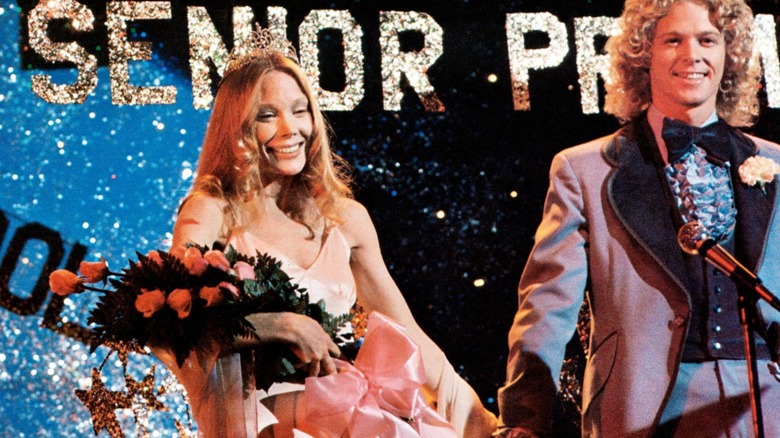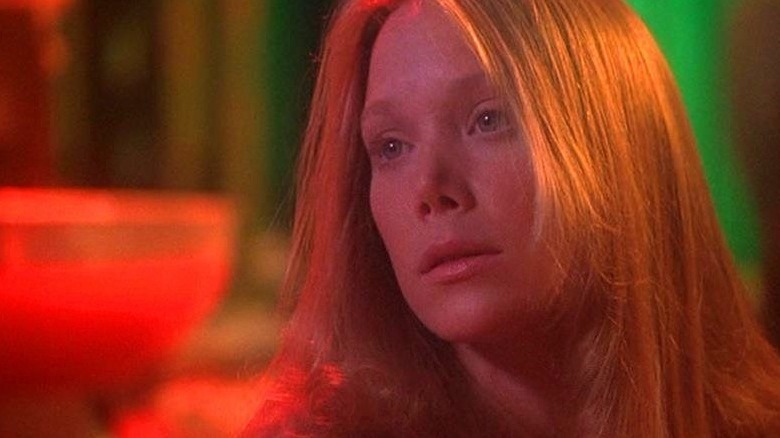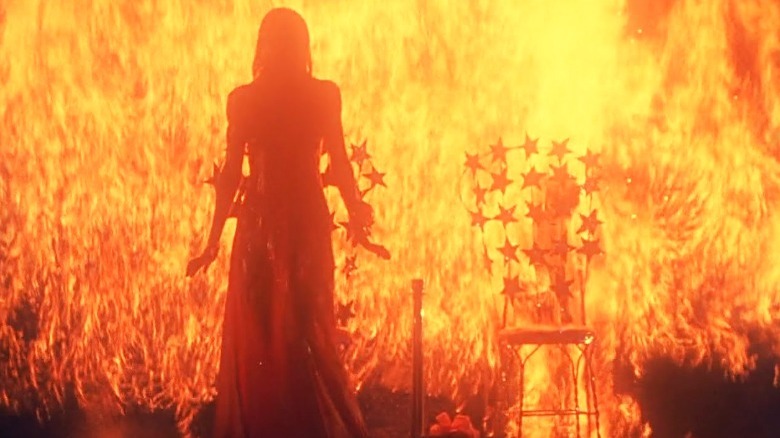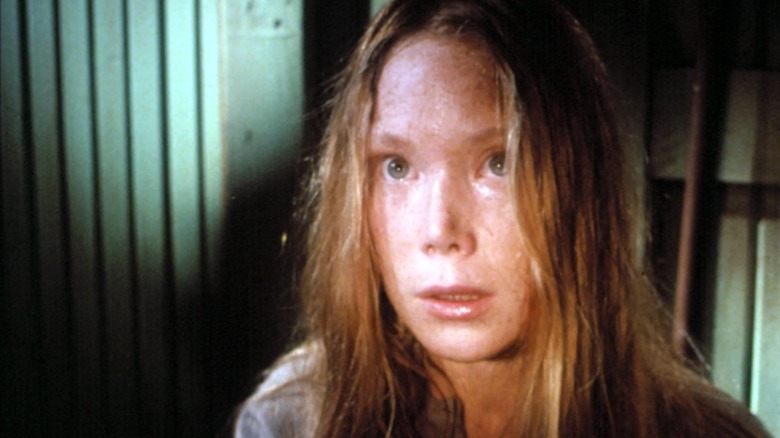1976's Carrie Ending Explained: Feminine Rage, Unleashed
In Brian De Palma's "Carrie," the image of Carrie White (Sissy Spacek) doused in pig's blood after being crowned prom queen emerges as a haunting portrait of a woman wronged. Minutes before her bullies humiliate her onstage, Carrie exudes an almost angelic beauty, a reflection of the compassion she holds in her heart despite being bruised by the cruelties of life. However, the moment her pretty pink prom dress turns red while bystanders look on in horror, something innate snaps inside Carrie. No longer does she extend compassion to those who do not deserve it — and even those who do. Primal feminine rage takes over, amplifying her telekinetic abilities, which unleash hell on Bates High. The message is clear: Vengeance is swift and uncompromising when an ostracized teenager decides to step into her power.
De Palma consciously modeled this enduring climactic image of Carrie on Gustave Moreau's painting "The Study For Lady Macbeth," which portrays the luminous subject flanked by what seems like rivers of blood. The metaphor of blood being innately connected to the reclamation of power (or an un-washable stain representing guilt, in Lady Macbeth's case) is developed throughout "Carrie," as the film begins with the titular figure being mocked for getting her period in the school shower. Both Stephen King (whose acclaimed novel the film is based on) and De Palma draw traditional (and now-dated) parallels between menstrual blood and empowered womanhood, although this biological process is mocked and shunned in the public eye.
Etching a character arc where telekinetic powers are inextricably linked to notions of womanhood can be problematic— but in De Palma's able hands, "Carrie" unravels like a taut horror-thriller. Its splashes of dark comedy only complement the film's binary tone, which oscillates between the saccharine and the gothic.
Her very existence, an act of rebellion
"Carrie" resonates with audiences across the board for many reasons. First and foremost, it etches a compelling, relatable portrait of teenage angst, underlining the growing pains of finding your identity in a world that feels rigged against you. High school can be an especially cruel space for those who do not fit into societal expectations of normalcy, a feeling that is heightened when one is bullied and emotionally abused. Carrie does not have any support systems that she can rely on: Her home environment is abusive and hostile, as her overbearing mother Margaret (Piper Laurie) perpetually torments her with a vitriolic brand of religious fundamentalism. For Margaret, the world is either sacred or profane, and any demonstration of autonomy is sinful in her eyes, which makes her hound Carrie with renewed vigor.
The only times when Carrie feels safe is in her own presence when she cradles herself in her arms and allows herself to process the extent of her powers. Being endowed with the ability to influence objects with your mind can be disorienting, but Carrie does not immediately abuse her telekinetic abilities for thrills or vengeance. Instead, she radiates with the quiet confidence of someone who is gradually aware of what they're truly capable of and embraces her sexuality by rejecting her mother's attempt to demonize her desires.
Although Carrie's story has been told and retold via various lenses and assumes many tints, the heart of the story remains the same: It is about a girl who experiences the horrors of isolation, where her very existence becomes a quiet act of rebellion. When pushed too far, she brings about literal carnage and bloodbath, too broken to care whether those trapped inside are cruel or kind-hearted.
The many endings of a blood-soaked tale
Stephen King, who endorses Brian De Palma's adaptation of his novel, has stated on many occasions that he considers the film's ending more fitting than that of the novel. Those familiar with the novel would agree that while King's ending is suited solely for the purposes of novelistic storytelling, De Palma's highly-stylized, aesthetically-brilliant rendition of the ending works better from a purely cinematic point of view. Carrie's breakdown in the novel is much more deliberate and brutal, as she consciously seeks out her classmates to torment them and makes sure that they are beyond outside help. In fact, the school alone is not the target of her incandescent rage: Carrie makes sure that the whole town suffers her wrath, as she detonates the main gas lines and hunts down her tormentors. As she is on the verge of dying, Sue approaches her, and the two connect on a visceral, psychic level before Carrie breathes her last.
In contrast, De Palma utilizes his telltale split screens to unravel a saga of blood-soaked revenge that seems more guttural and trance-induced than consistently deliberate. Yes, Carrie shuts her classmates inside the burning building, but she does not seek out her bullies after her telekinetic floodgates open. Instead, she is forced to explode the car her tormentors are in to safeguard herself, and has no choice but to crucify Margaret after she stabs her daughter in the back. Heartbroken and betrayed by her own kin, Carrie screams in agony, allowing her power to consume and destroy, and she dies after her house topples under the weight of her trauma-fueled angst.
However, the crowning glory of De Palma's ending is the dream sequence that is the stuff of nightmares: the bloodied hand of a dead girl rising from the grave.
The unshakeable weight of trauma
Unlike Stephen King's ending, which settles for an imperfect, yet compassionate mirroring between two complex female characters, Brian De Palma's ending lingers on rage, which comes back to haunt from beyond the grave. Sue, who alternates between bully and sympathizer, ultimately finds herself identifying with Carrie's pain. However, there is no closure for either Carrie or Sue — while Carrie is crushed under the weight of her own pain, Sue is compelled to carry the guilt of Carrie's death, which is now a source of horror to her. Even the way in which Carrie reaches out to Sue in the dream is aggressive, as her hand shoots up from her grave and grabs Sue, pulling her inside the crypt.
Although Sue is not nearly as cruel as the other bullies at school, she ends up shouldering the guilt of Carrie's tragic demise, which fuels bottomless grief and the fear of suffering a similar fate. Despite De Palma's sympathetic portrayal of Carrie, this shock ending paints her as a creature of terror in Sue's mind, who will now be forever haunted by the specter of a girl wronged. Within the ambit of genre tropes and the film's gothic overtones, this sequence works remarkably well, jolting audiences out of a latent state of complacency or the misconception that the worst is truly over.
If anything, this ending is more tragic. Despite attempts by those like Sue to understand and comfort Carrie, she breathes her last feeling cornered and betrayed by the world. Her rage, linked to her personhood and autonomy, momentarily paves the way to liberation in the form of vengeance, but is too much to sustain her. In the end, she remains condemned, even in death, only understood in surreal fragments through channeled feminine grief, and rage.



